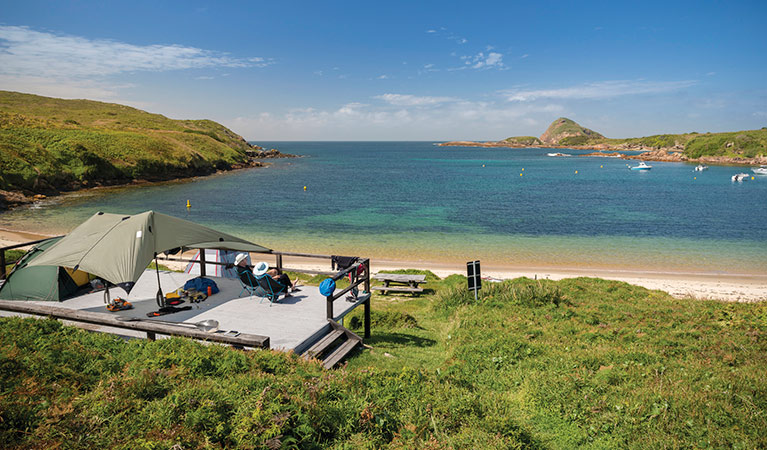Broughton Island campground
Myall Lakes National Park
Overview
Broughton Island campground is the only place in NSW where you can camp among an active seabird colony.
| Number of campsites | 5 |
|---|---|
| Camping type | Tent, Remote/backpack camping |
| Facilities | Toilets |
| What to bring | Drinking water, cooking water, food supplies |
| Entry fees |
No park entry fees apply at this campground. See vehicle fees for other areas in Myall Lakes National Park. |
| Bookings | Bookings are required. Book online or call the National Parks Contact Centre on 1300 072 757. |
| Please note |
|
Camping on Broughton Island is a truly special experience. Located in Myall Lakes National Park, you'll be camping amongst an active seabird colony- it’s a key breeding site for wedge-tailed shearwaters.
There are plenty of opportunities for water activities, including swimming, fishing, boating, snorkelling and scuba diving. You’ll find sandy beaches within Esmeralda Cove.
With only five campsites, you’ll feel like you own the island. The campground is fairly basic, so you’ll have to bring all your equipment and supplies with you, including water. You must book and pre-pay for a campsite prior to arriving at the island.
Nearby
-

Broughton Island walking tracks
Broughton Island walking tracks are a great way for nature lovers to explore this remote island, accessible by boat from Port Stephens. Follow this family-friendly network of walking tracks to wild beaches and stunning lookouts.
Map
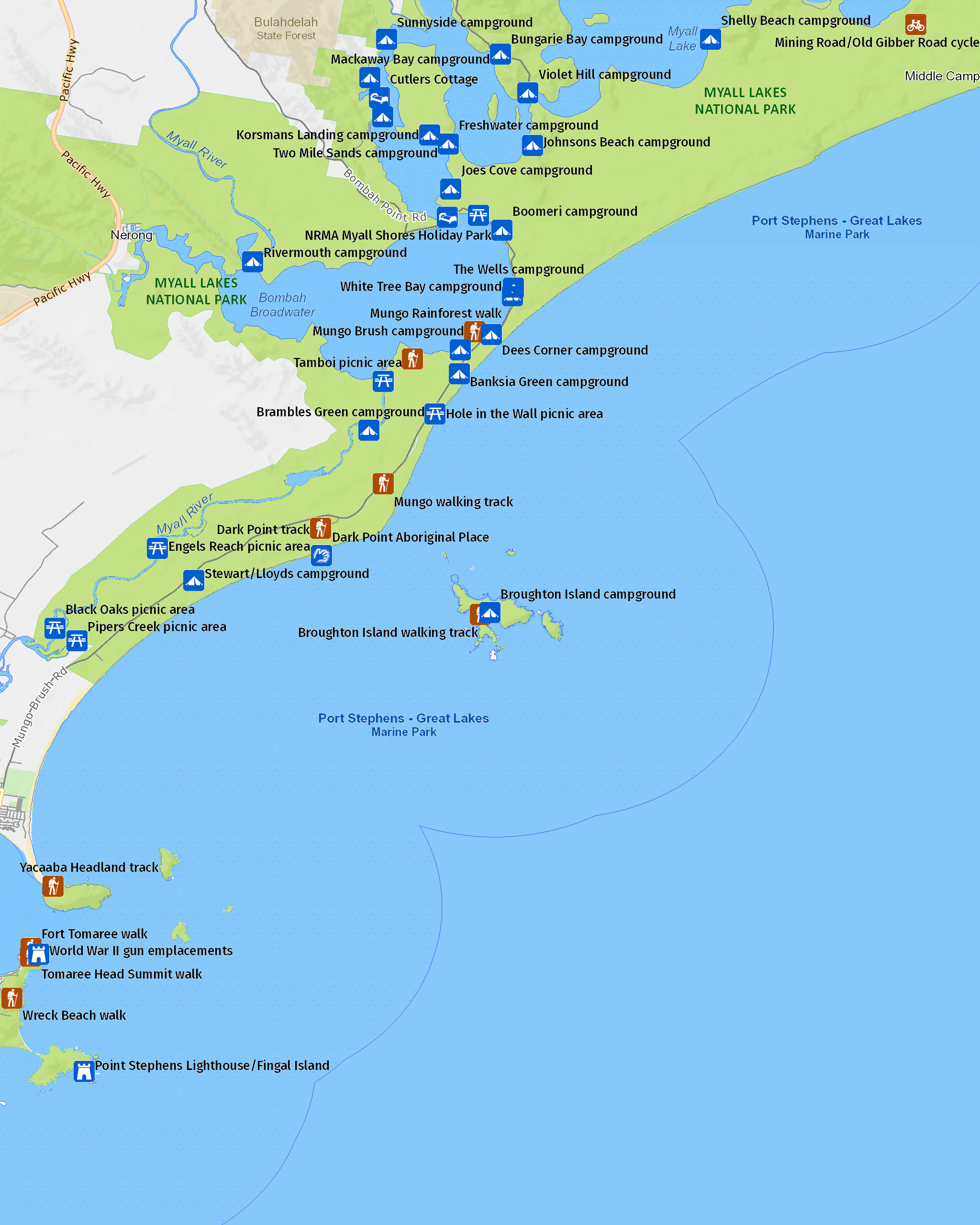
Map legend

Local alerts
For the latest updates on fires, closures and other alerts in this area, see https://www.nationalparks.nsw.gov.au/camping-and-accommodation/campgrounds/broughton-island-campground/local-alerts
Bookings
- National Parks Contact Centre
- 7am to 7pm daily
- 1300 072 757 (13000 PARKS) for the cost of a local call within Australia excluding mobiles
- parks.info@environment.nsw.gov.au
Operated by
- Anna Bay office
- Monday to Friday, 8.30am to 4.30pm.
- 02 4984 8200
- npws.huntercoast@environment.nsw.gov.au
- 4154 Nelson Bay Road, Anna Bay, NSW 2315
Park info
- in Myall Lakes National Park in the North Coast region
Myall Lakes National Park is always open but may have to close at times due to poor weather or fire danger.
-
Park entry fees:
$8 per vehicle per day.
The park has coin/card operated pay machines at Mungo Brush campground. Day passes are also available from the Manning Great Lakes Area Office, Bulahdelah Visitor Information Centre and the Hawks Nest Newsagency. You can also pay for your visit via the Park’nPay app.
Bombah Point ferry fees may also apply (cash payment only).
Buy annual pass
Visitor info
All the practical information you need to know about Broughton Island campground.
Getting there and parking
Broughton Island campground is part of Myall Lakes National Park. Access is by vessel only. If travelling by private vessel, you should register your movements with Marine Rescue Port Stephens on marine radio prior to travel, or you can organise transport with a tour operator. Please be advised that tour operator schedules and prices vary, so we recommend that you contact the tour operator before booking your campsite to ensure that transport is available and the costs suit your requirements.
Guided tours and transport services run to the island by the following tour operators:
- Moonshadow - TQC Cruises (guided day trips only)
- Aquamarine Adventures (guided tours only)
Access to the campground is via Esmeralda Cove, on the south-eastern side of the island. The moorings in Esmeralda Cove are all privately owned and cannot be used by the general public.
Best times to visit
There are lots of great things waiting for you in Myall Lakes National Park. Here are some of the highlights.
Autumn
A good time to visit when the weather is a little cooler and the park is less busy.
Spring
Magnificent wildflower displays as they bloom across the heathlands.
Summer
Look for dolphins swimming among the waves.
Winter
Head to Sugarloaf Point to watch for whales on their annual migration.
Weather, temperature and rainfall
Summer temperature
Average
19°C and 27°C
Highest recorded
41.5°C
Winter temperature
Average
10°C and 19°C
Lowest recorded
1.1°C
Rainfall
Wettest month
May
Driest month
November
The area’s highest recorded rainfall in one day
257.8mm
Facilities
- There are three timber camping platforms and two grassy sites. You can select which site you’d like when booking.
- If you decide to camp on a timber platform, bring some extra rope to assist in securing tents to anchor points.
- Water is not available at this campground.
- Weather and sea conditions can change rapidly and may delay your departure from the island, so be prepared with adequate food supplies.
- There is no power on the island
- There is very little shade on the island
- Campers are required to take all rubbish with them on departure
Toilets
- Non-flush toilets
Maps and downloads
Accessibility
Disability access level - no wheelchair access
Prohibited
- Fireworks are prohibited
- Amplified music is not permitted
Camp fires and solid fuel burners
Gathering firewood
Generators
Pets
Pets and domestic animals (other than certified assistance animals) are not permitted. Find out which regional parks allow dog walking and see the pets in parks policy for more information.
Smoking
NSW national parks are no smoking areas.
Learn more
Broughton Island campground is in Myall Lakes National Park. Here are just some of the reasons why this park is special:
Ancient connections
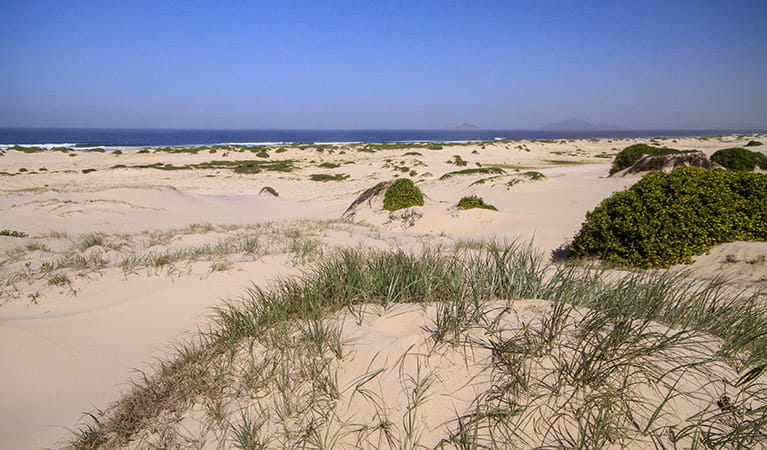
Myall Lakes National Park is part of the Country of the Worimi Aboriginal people, who used the area's natural resources, like freshwater lakes, the ocean and native flora and fauna to live a traditional fisher-hunter-gatherer lifestyle. Much evidence of their long connection with this Country can be seen today throughout the middens in the park. The landscape of Myall Lakes includes important spiritual sites that are an important part of the identity of local Aboriginal people. Make sure you visit Dark Point Aboriginal Place while you're at visiting the park. This rocky headland has been of significance to Worimi people for at least 4000 years. The clans or nuras (family groups) within the Worimi people would gather together here for ceremonies and feasts.
- Dark Point Aboriginal Place Dark Point Aboriginal Place, in southern Myall Lakes National Park, is a culturally significant site for the Worimi people with scenic coastal views across to Broughton Island.
- Mungo walking track Mungo walking track offers a variety of Aboriginal and historic sites, diverse vegetation, and mountain biking in Myall Lakes National Park, near Hawks Nest.
Go fish
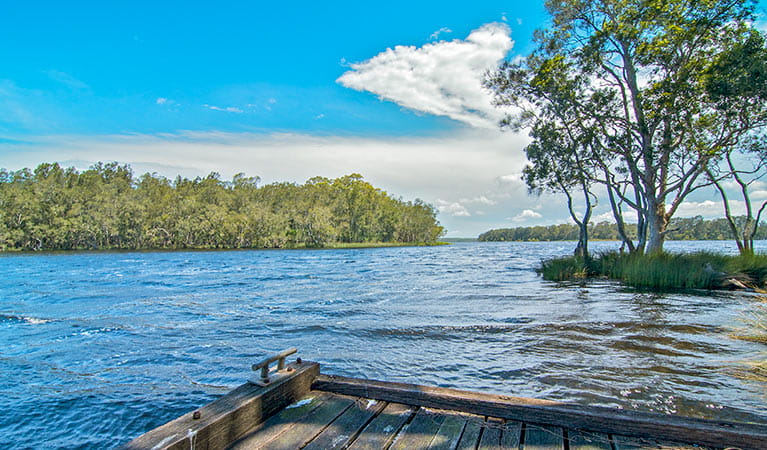
Fishing is a popular activity in Myall Lakes, with catches likely to include bream, whiting, Australian salmon, flathead and mullet. There are lots of great places in the park to throw in a line, like the beaches, lakes or rivers. Try fishing from your boat or for a relaxing day on the water you could try a spot of kayak fishing. At Myall Lakes you can also go camping, boating, swimming and canoeing. And when you’ve tried all of those, you can explore the park on foot, by 4WD or bike, stopping for a spot of bird watching or to enjoy a picnic or barbecue lunch along the way. Whatever your interests, there is bound to be something that takes your fancy.
- Mining Road to Old Gibber Road cycling trail Mining Road to Old Gibber Road cycling trail is an easy bike ride within Myall Lakes National Park. You can complete the ride in one day or take your tent to camp overnight.
- Mungo Rainforest walk Enjoy a short and easy rainforest walk with the birds in Myall Lakes National Park, not far from Buladelah. Afterwards, you can enjoy a picnic or barbecue at Mungo Brush.
Internationally recognised wetlands
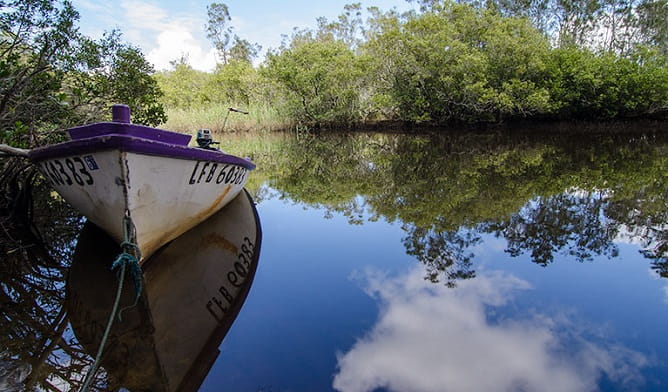
Since 1999, this internationally recognised wetlands site, has been listed under the Ramsar Convention due to its diverse mosaic of near-natural wetlands, within a relatively unmodified coastal lake system. There are 18 different wetland types with extensive interconnected lake and river systems within the forested wetlands and swamps that fringe the waterways, rocky and sandy shores, and offshore islands off the coastline. This wetland site houses a complex variety of habitats with rich biodiversity, including threatened species and migratory birds protected under international agreements. The Myall Lakes wetlands also have a high cultural and social value as they occur within the traditional lands of the Worimi Aboriginal people, where the varied wetlands, environments and abundant resources provided an ideal living environment. Evidence of this traditional occupation exists across the landscape, including the Dark Point Aboriginal Place.
Plants and animals protected in this park
Animals
-

White-bellied sea eagle (Haliaeetus leucogaster)
White-bellied sea eagles can be easily identified by their white tail and dark grey wings. These raptors are often spotted cruising the coastal breezes throughout Australia, and make for some scenic bird watching. Powerful Australian birds of prey, they are known to mate for life, and return each year to the same nest to breed.
-
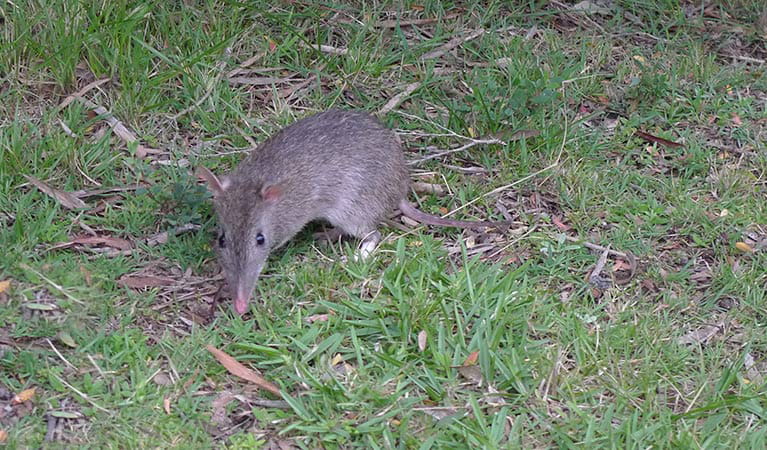
Long-nosed bandicoot (Perameles nasuta)
A nocturnal marsupial and one of the smaller Australian native animals, the long-nosed bandicoot is found across eastern Australia. Populations in the Sydney region have dwindled since European settlement, leaving only endangered colonies in inner western Sydney and at North Head, near Manly. The long-nosed bandicoot has grey-brown fur and a pointed snout which it uses to forage for worms and insects.
-
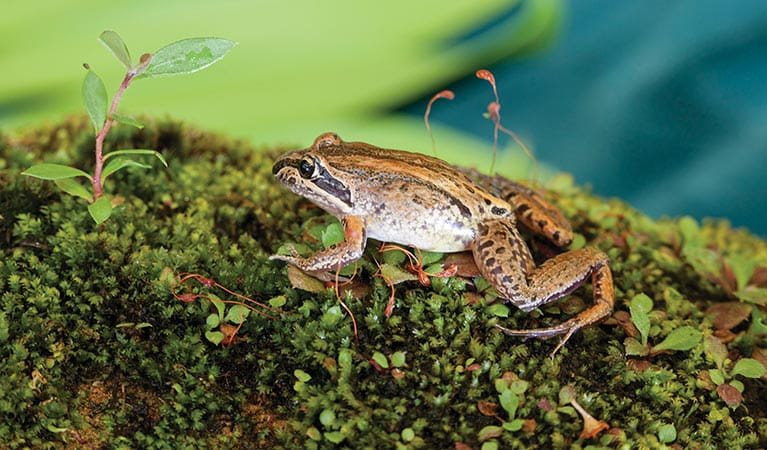
Brown-striped frog (Lymnastes peronii)
One of the most common frogs found in Australia, the ground-dwelling brown-striped frog lives in ponds, dams and swamps along the east coast. Also known as the striped marsh frog, this amphibian grows to 6.5cm across and has a distinctive ‘tok’ call that can be heard all year round.
-
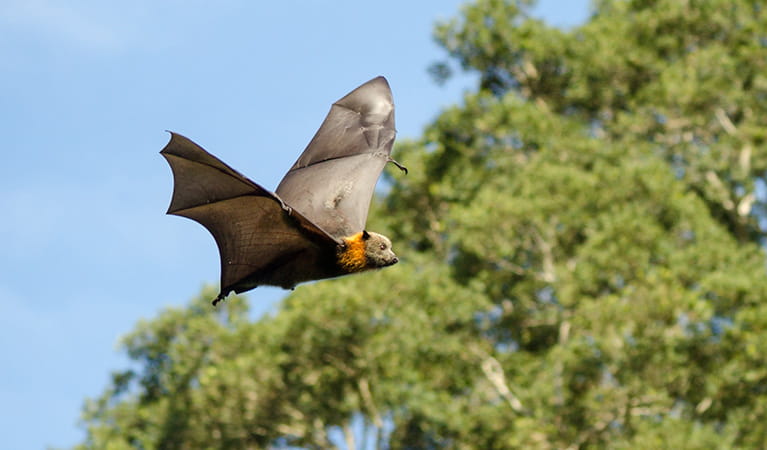
Grey-headed flying-fox (Pteropus poliocephalus)
The grey-headed flying fox is Australia's largest native bat, with a wingspan up to 1m. This threatened species travels up and down south-eastern Australia and plays a vital role in pollinating plants and spreading seeds in our native forests.
Plants
-
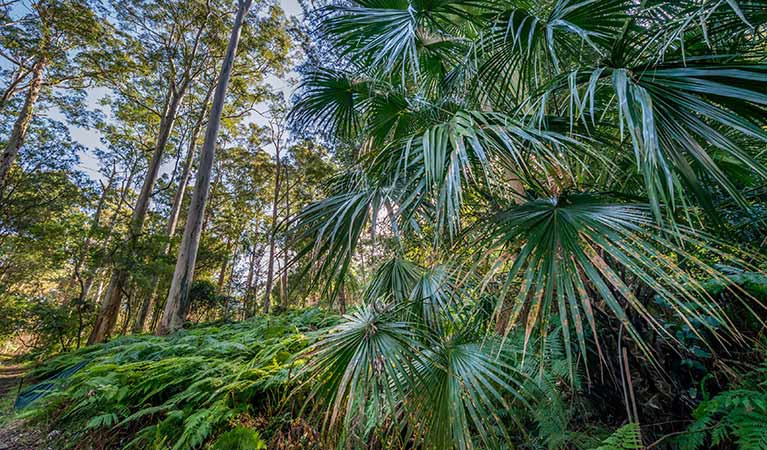
Cabbage palm (Livistona australis)
With glossy green leaves spanning 3-4m in length and a trunk reaching a height of up to 30m, the cabbage tree palm, or fan palm, is one of the tallest Australian native plants. Thriving in rainforest margins along the east coast of NSW, in summer this giant palm produces striking spikes of cream flowers which resemble cabbages.
-
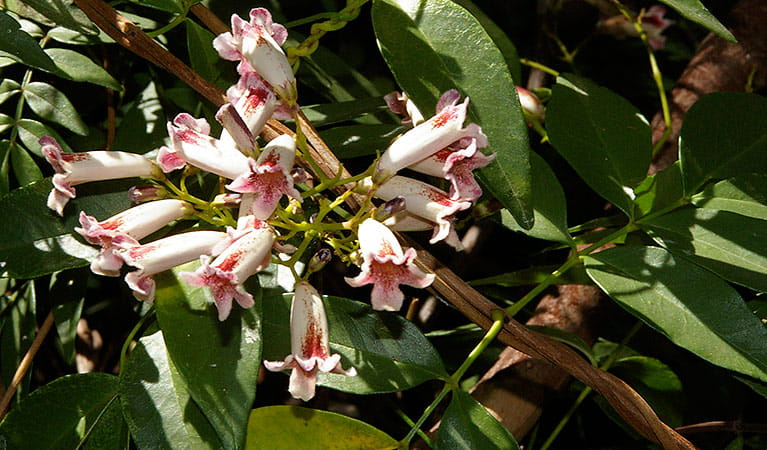
Wonga wonga vine (Pandorea pandorana)
The wonga wonga vine is a widespread vigorous climber usually found along eastern Australia. A variation of the plant occurs in the central desert, where it resembles a sprawling shrub. One of the more common Australian native plants, the wonga wonga vine produces bell-shaped white or yellow flowers in the spring, followed by a large oblong-shaped seed pod.
Environments in this park
Education resources (1)
Bookings
- National Parks Contact Centre
- 7am to 7pm daily
- 1300 072 757 (13000 PARKS) for the cost of a local call within Australia excluding mobiles
- parks.info@environment.nsw.gov.au
Operated by
- Anna Bay office
- Monday to Friday, 8.30am to 4.30pm.
- 02 4984 8200
- npws.huntercoast@environment.nsw.gov.au
- 4154 Nelson Bay Road, Anna Bay, NSW 2315
Park info
- in Myall Lakes National Park in the North Coast region
Myall Lakes National Park is always open but may have to close at times due to poor weather or fire danger.
-
Park entry fees:
$8 per vehicle per day.
The park has coin/card operated pay machines at Mungo Brush campground. Day passes are also available from the Manning Great Lakes Area Office, Bulahdelah Visitor Information Centre and the Hawks Nest Newsagency. You can also pay for your visit via the Park’nPay app.
Bombah Point ferry fees may also apply (cash payment only).
Buy annual pass
What's nearby:
Things to do (79)
- 4WD touring (3)
- Aboriginal culture (10)
- Adventure sports (3)
- Beach (9)
- Birdwatching and wildlife encounters (33)
- Cafes and kiosks (1)
- Canoeing/paddling (11)
- Cultural heritage (1)
- Cycling (8)
- Environmental appreciation/study (1)
- Fishing (14)
- Historic heritage (16)
- Horse riding (1)
- Picnics and barbecues (23)
- Road trips and car/bus tours (2)
- Sailing, boating and cruises (4)
- Sightseeing (22)
- Snorkelling and scuba (2)
- Surfing (8)
- Swimming (17)
- Walking (28)

